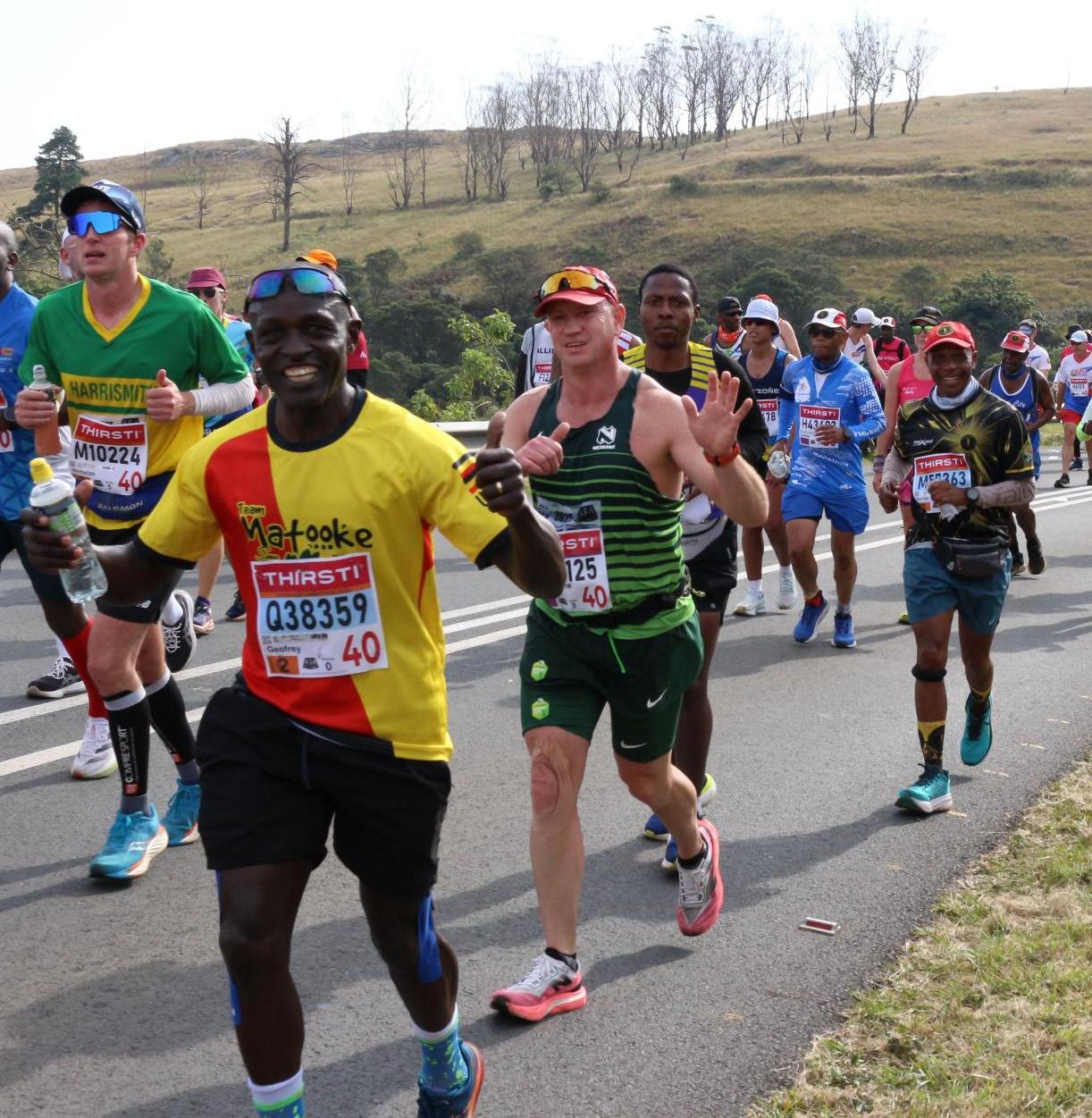TheVibe STAFF BULLETIN









Pg. 3 From then to Now...
Pg. 8 What is in the Book?
Pg. 11 Ancient Wisdom meets the Modern Workplace
Pg. 14 My Career Growth Journey...
Pg. 16 The Call to Courage...
Pg. 20 Book Review: My Life in Full (Indra Nooyi)
Pg. 24 Excellence over Gender...
Pg. 25 The NSSF Fellowship Altar
Pg. 28 The Invisible Perks Effect...
Pg. 30 Humility - the Strength no one Talks About Pg. 32 Understanding the Dimensions of Wellness
Pg. 34 NSSF continues to lead Digital Transformation...
Pg. 37 Powering the Fund’s Vision, one Digital Link at a time
Pg. 39 Your £100M Mission: Welcome to Fantasy Premier League
Pg. 43 The Moment Football came Back
Pg. 46 The Comrades Marathon 2025

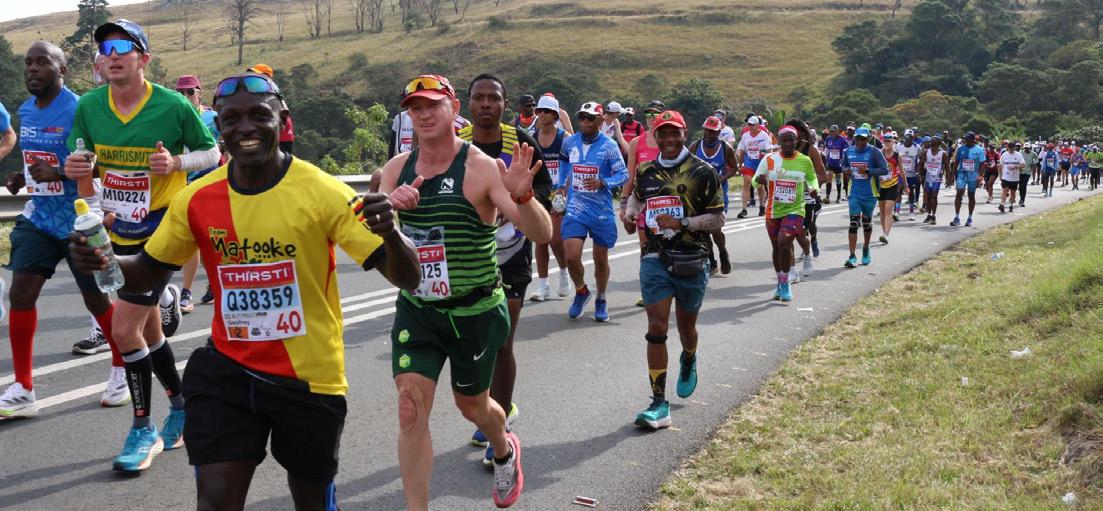

Dear Colleagues,
It is my pleasure to welcome you to Issue No. 11 of our Staff Bulletin - an informative platform through which we share, connect, and celebrate one another as staff of the Fund. This bulletin is a reflection of our collective spirit and an important way of keeping our community informed and inspired.
I would like to take this opportunity to once again thank you all for your consistent demonstration of strong performance, which continues to align with and support our Vision 2035. Your hard work, commitment, and dedication are the driving forces behind the Fund’s progress, and it is through this culture of excellence that we remain a trusted institution. I encourage each of us to sustain this high-performance culture, while also tapping into and strengthening our internal support systems such as coaching and mentorship. By investing in one another, we grow not only as a Fund but also as individuals - becoming better and stronger in our personal and professional journeys.
In July this year, we celebrated an important milestone through the EDRMS Conference, where the Fund proudly showcased our capability and innovation in digital records management. This conference reflected our ability to thrive in the modern era of information management. I extend my heartfelt appreciation to the organizing team for their tireless efforts in making this conference a success.
We were also delighted to take part in the Global Customer Connect Week celebrations, which internally climaxed last Friday. This was a timely reminder that our members remain the bedrock of why we exist. Let us remain steadfast in being member-focused, because serving our members with excellence is both our duty and our pride.
The
People and Culture Department—and the HR Business Partner team in particular—remain deeply committed to staying closely connected with you. It is both our responsibility and privilege to ensure that you feel supported, appreciated, and truly valued as a member of the Fund’s family every single day.
Finally, as we celebrate a landmark 40th anniversary, let us take a moment to reflect on how far we have come. Forty years is not just a number; it is a story of resilience, dedication, and shared purpose. This milestone should inspire us to take pride in our legacy while renewing our commitment to serving with even greater resolve in the years ahead.
Thank you for your continued dedication and for making the Fund the remarkable institution it is today. I look forward to us achieving even more together.
Olivia Mirembe HR Business Partner


AsBy Remigious Kaggwa Engagement Specialist
the National Social Security Fund (NSSF) marks 40 years of existence, it is only fitting that we pause to reflect on the journey that has brought the Fund to where it stands today. While numbers and milestones tell part of the story, the people who have walked this path are the true custodians of our heritage.
One such individual is Mr. Paul Sam Bwayo, a Senior Audit Manager, Operations in the Internal Audit Department, and also the Chairman of the NSSF Staff SACCO. Having served the Fund for over two decades, Mr. Bwayo has witnessed its transformations - big and small - through the lenses of operations, culture, and governance. In this conversation, he shares candid reflections on the Fund’s evolution, the highs and lows that shaped its identity, and his perspective on the road ahead.
1. Mr. Bwayo, take us back to the beginning. Do you remember your first days at NSSF, and what was the organisation like at that time compared to what it has become today?
I joined the Fund in September 2002 as Internal Auditor under the Internal Audit Department. The headquarters were located on Lumumba Avenue in three old single-storey buildings, along with other temporary structures. In 2003, the headquarters were temporarily relocated to Workers’ House to pave the way for the construction of the Pension Towers.
At that time, the organization was wellstructured, with a Board of Directors appointed by the Ministry of Gender and Labour, a Management team, and a staff of about 250 people, including temporary staff.
In 2004, following the dismissal of the Managing Director, H.E. the President issued a directive that placed the Fund under the supervision of the Ministry of Finance, Planning, and Economic Development.
The Fund had several departments, each headed by a Director, including Human Resources, Finance, Benefits, Internal Audit, Operations, Information Technology, and Legal Services. The core activities of the Fund, just like today, included registration, collection of contributions, investment, and payment of benefits, distributed across the existing structure.
At the time, most systems were largely manual, with minimal automation. The main system in use was the Social Security Data Management System (SSDMS), developed in-house to support operations.
“
The difference between then and today is that in subsequent Staff Handbooks, a more detailed Code of Business Conduct and a Disciplinary Code - with clear examples of dos and don’ts - were incorporated.
2. Looking at those early years, how did staff live the values of the Fund back then? And do you currently see any sharp contrasts between then and now?
In 2004, following a restructuring undertaken by Ms. Ernst & Young, a Staff Handbook was developed. It included sections on values, standards of conduct, professional ethics, and other guidelines to direct the business conduct of staff. As is the case today, there were instances of breaches of values and standards of conduct, which often resulted in appropriate disciplinary action being taken against

The difference between then and today is that in subsequent Staff Handbooks, a more detailed Code of Business Conduct and a Disciplinary Code - with clear examples of dos and don’ts - were incorporated. This made it easier to monitor and report breaches, as well as to investigate and take disciplinary action as necessary.
3. You’ve seen colleagues come and gosome leaving lasting marks, others fading quietly. Who are some of the unforgettable characters you worked with, and what made them so memorable?
I will focus on the leadership level, specifically the Managing Director. From the time I joined in 2002 up to 2006, there was turbulence in leadership at both the Board and Management levels. We had Mr. Mpuuma Lenard, who was dismissed in 2004 after some positive strides had been made in real estate development. During his tenure, the Fund acquired the Lubowa land (through a swap with the National Housing and Construction Corporation) and the Nsimbe land (through a joint venture with Mugoya). These strategic pieces of land remain at the Fund’s disposal for development.
Mr. Lenard was dismissed in 2004 after a parliamentary probe by COSASE, following the disposal of the Bukoto rental flats in favor of real estate development. He was replaced by the Corporation Secretary, Mr. Bandebire Martin, who served in an acting capacity from 2004 to 2007. During this period, the Fund’s real estate development was halted.
In 2007, a new Managing Director, Mr. Chandi Jamwa, was appointed. Having previously acted as a consultant, he personally steered the development of the Fund’s first comprehensive and formal Strategic Plan. I must confess that the transformation journey we are still pursuing today was ushered in by his work. It marked a paradigm shift from the old Fund to the modern institution we have steadily grown into.
Mr. Jamwa is particularly memorable because he drove business change at an exceptionally fast pace. Within less than 18 months as Managing Director, he rejuvenated most real
estate activities, including breaking ground for the construction of Pension Towers, as well as initiating several investment projects across the portfolio. However, he was dismissed in 2008 and replaced first by Mr. Bandebire, and later by Mr. Isabirye Grace.
In 2010, Mr. Byarugaba was appointed Managing Director. He is the longest-serving leader in this role, with over 10 years of stable service. His tenure enabled the Fund to achieve remarkable growth in asset size and other areas. Notably, in my view, his biggest achievement was when the Fund declared an interest rate of 15% in financial year 2017/2018.

4. In over two decades of service, you’ve seen the Fund through triumphs and turbulence. What would you say has been the toughest season in its history since you joined and how did it feel to live through it?
I will use events to demonstrate the challenges that I think have posed the toughest seasons for the Fund. In 2004, just two years into my employment, both the Board and the Managing Director were dismissed. A restructuring exercise followed, with several recommendations that, however, remained unimplemented until 2007.
In 2007, a new Managing Director was appointed, ushering in another restructuring. Just as the recommendations from this exercise were beginning to be addressed, a new wave of turbulence set in, culminating in a parliamentary probe and the dismissal of both the Managing Director and Deputy Managing Director in 2008.
During the transition from 2008 to 2010, the Fund was led by two Acting Managing Directors. Due to the brevity of their terms, they were unable to steer the business beyond collections, fixed income, and equity holdings. Real estate development remained dormant during this period.
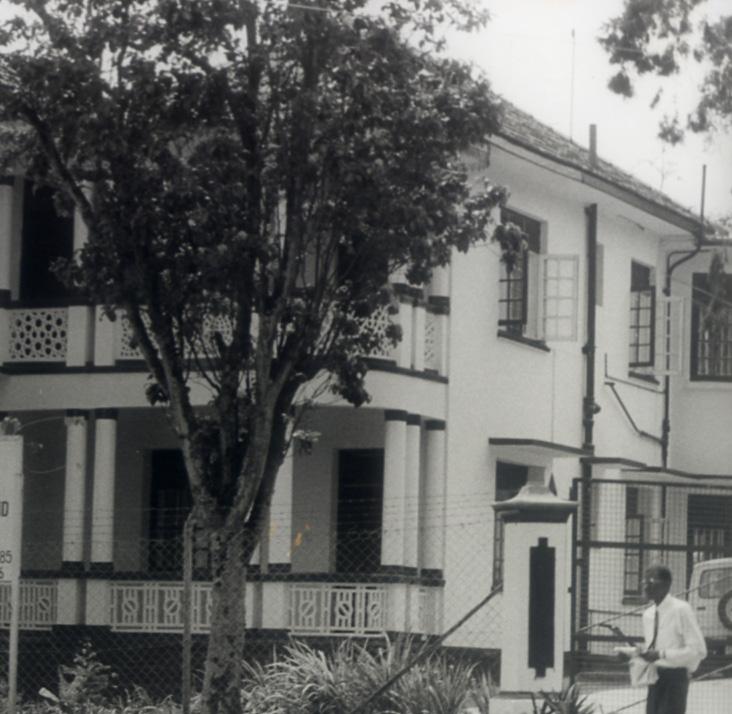
In 2010, a new Board of Directors, a Managing Director, a Deputy Managing Director, and a Corporation Secretary were appointed. For the first time, the Fund experienced its longest period of stable leadership—over 10 years— under Mr. Byarugaba. This era saw exponential growth until the end of his contract in 2022, followed by a COSASE probe in early 2023.
5. Stepping away from the Fund for a moment - what lessons about life and people have you drawn from working here for so long?
Drawing from my experience, I have learned that one should be patient, adapt flexibly to good change and live by the professional, institutional (Fund) and spiritual values applicable.
In executing your roles, comply with laws/ policy’s/guidelines and remain objective, formal and do not take work issues personal.
Avoid affiliation to camps, especially related to work whatsoever, because they never stand a test of time.
“
Broadly the adoption of technology and automation to ease the conduct of business amidst the growing scope of the Fund has been transformational.
6. Many of us only see the “NSSF of today.” In your eyes, what is the single biggest transformation you’ve witnessed in the past 20 years that outsiders might not easily appreciate?
Broadly the adoption of technology and automation to ease the conduct of business amidst the growing scope of the Fund has been transformational. Specifically, the EDRMS Project has enabled remote/paperless conduct of business, controlled access (amidst data protection and privacy requirements) and real time archival/reference which all drive efficiency and cost savings.

7. You also chair the NSSF Staff SACCO. From that vantage point, what has the SACCO taught you about community among staff?
Communal pooling of resources is the easiest and safest way to grow capital for personal development. There are no hidden strings attached for accessing funds, especially in form of cheap credit from SACCO. There is also room to withdraw if one has adequate savings more than one’s total credit. However, in the spirit of building capacity to access development capital for bigger future opportunities, I would discourage withdrawal of savings whatsoever.
8. When you think of your own journey, what has kept you rooted here all these years - was it loyalty, opportunity, people, or something more personal?
My employment at the Fund has been exclusively in Internal Audit, where I have provided assurance services. I am convinced that if I—and indeed other employees—serve to the best of our ability, the Fund’s going concern will be guaranteed well beyond our tenure. This means that members joining today, including our children and even grandchildren, will be assured of receiving their benefits when they become due. This belief alone has motivated me to serve in this institution with a national outlook, especially to safeguard the interests of future generations as much as possible.
As an Internal Auditor, one is expected to be a role model—living the Fund’s values,
upholding professionalism, relating well with stakeholders, performing at the highest level, and complying with all applicable laws, policies, and procedures. I have endeavored to respect these requirements fully, and this commitment has informed my uninterrupted service at the Fund.
In addition, the Fund’s remuneration and benefits regime has continually improved over the years, comparing favorably with the wider employment market. This has been a strong incentive to stay, even when other opportunities have presented themselves elsewhere.
9. Finally, if NSSF were a 40-year-old human being - standing at a crossroads, reflecting on their youth but also eyeing the future - what advice would you whisper in their ear?
I would tell the NSSF 40-year-old guy that you have done your best in balancing your investment portfolio; however, the real estate class has not been rosy, resulting in turbulence over the years. I would advise that it’s time you maintained or toned down your appetite (asset allocation) in real estate to the lowest possible to minimize more injury.
“
Communal pooling of resources is the easiest and safest way to grow capital for personal development.
is
A reader’s thoughts on the beauty of reading.


By Donnah Kyakuwaire Compliance Team Lead
“ If you are struggling to pick up reading as a habit, fiction is the place to start.
Curiosity has always led me to incredible journeys. Give, for example, that midmorning—my fifteen-year-old self, going about my house chores, and then getting to the visitor’s room and wondering: who was the person we were hosting in our home? I mean, I knew her name, she was my aunt, but who was she beyond what we saw? Alone in her room! What better way to find out than to snoop?
Soon, my hands and eyes were in her suitcase and handbag, making sense of her personal effects. And that is when I landed on the mighty Gifted Hands by Ben Carson. Interesting title! I
thought. I turned to the back cover to read the synopsis, and I was hooked, literally, for life. In those pages, I found the power to redefine and rewrite my story. As a teenager struggling with low self-esteem, I learnt that I could be more, no matter the circumstances surrounding me. Gifted Hands had such a profound effect on me that even some of my parenting choices now are informed by it.
I am still obsessed with knowing people. That is why I read many biographies. I’m talking about everyone I can get my hands on: Malala, BMK, the Obamas, Maya Angelou, Rhoda Kalema, Sheila Johnson, the Nabagereka, Ellen Johnson Sirleaf, Trevor Noah, Joel Osteen, Kamala Harris, Martin Aliker, Will Smith, Indra Nooyi, Gary Skinner, Richard Branson, and many more. Stories about people’s lives will have you reflecting, gasping for breath, wailing, mistrusting and trusting, screaming for joy, and most importantly, learning valuable life lessons from people you would otherwise never get a chance to meet. Again, this is what you will find in a book: living a thousand lives in a single lifetime and opportunities to learn from the bravery, experiences and mistakes of others.
When I meet someone, I ask what books they have read, books that have stayed with them, really enjoyed, or can recommend. In those books, I don’t see paper and ink—I see a doorway into a person. I see a version of that person revealed in what they choose to read. Book lists and reviews from Obama, Bill Gates and Adam Grant have not only been fantastic sources of new book choices but also very helpful in understanding where the minds of these world leaders are.
Some of the most real books I have read have been works of fiction. Yes, I just put real and fiction in the same sentence, because fiction is many borrowed realities put together, not things constructed out of thin air. At the heart of fiction is its ability to capture human imagination and to craft the uncomfortable, taboo, and unexplored into beautiful stories. Ugandan and African authors are my all-time favourites because their stories are relatable, closer to home, sumptuous, and sprinkled with a bit of scandal. If you are struggling to pick up reading as a habit, fiction is the place to start. There is that one author for everyone that will turn the switch on, hence no need to despair.
My favourite African authors here include the phenomenal Jennifer Nansubuga Makumbi, Bolu Babalola, Chimamanda Ngozi Adichie (I can see you saying, of course, very predictable). I have also been recently introduced to NoViolet Bulawayo and Jackson Biko, and I’m loving them.
Before I could afford them, if I found a book, I would ensure the owner forgot it. Don’t think stealing, think near, but not in plain, obvious sight for you to remember it, especially if you are in a rush. I wasn’t trying to take, I was trying to hold onto a world, a perspective, a secret someone else had written down but I needed to hear. That is how I got to read the book that has

“
So, you can’t afford a book yet? Borrow or get creative, read fast and return. Do not try this hack with me though!
influenced me the most: Battlefield of the Mind by Joyce Meyer. That book didn’t just open my eyes; it freed my 20-year-old mind. There were words in that book that felt like they were written with me in mind. Fear, doubt, shame; those voices that camped in the corners of my mind, finally had names, and more importantly, I was given the tools to confront them.
So, you can’t afford a book yet? Borrow or get creative, read fast and return. Do not try this hack with me though!
I have learnt that not every book is mine to read. Smut books? No, thank you. I can’t allow such content to inhabit my mind. I need to guard what lives in there, because what you feed your mind eventually takes root. And some roots, you don’t want. Also, not every book goes down easily. I struggle with self-mastery and improvement books, but because I need them, I force myself through them with all the courage I can muster. It’s a fight, honestly. I’ll pick up a title with the noblest of intentions, jot down the first few quotes, and then midway through, I’m distracted or questioning the author’s audacity and moral authority. This is where the book club has come in handy for me, dissecting these books into small manageable reads, a chapter, half an hour at a time.
So, what is in a book? A spark. A conversation. A world you didn’t know existed. Things peculiar and things common. A confrontation of your fears, biases, and insecurities. A question you didn’t know you needed to ask. A soft nudge towards courage. Knowledge and hope. Some books speak loudly, others speak slowly, but all of them speak, if you’re willing to listen.



By Amanda Achieng Owori Relationship Manager
Whenwe think about workplace wisdom, we usually picture TED Talks, management books, or maybe that one colleague who somehow always knows the solution to most problems. Nevertheless, believe it or not, most of the best advice for both personal and professional life is grounded in the Bible. The Bible is not just about Sunday mornings, it is packed with principles that are very relevant for the workplace.
It might not mention balance sheet and quarterly reports, but its characters faced challenges that feel strangely familiar in today’s workplace. Their stories carry timeless wisdom about leadership, resilience, communication and integrity. Here are some lessons we can borrow from their stories:
As a prophet and the only female judge of Israel, Deborah combined wisdom with courage, guiding her people in times of uncertainty. She took on leadership during a time when women were not typically in such roles, showing courage in the face of cultural expectation. She did not
just give orders; she inspired others to step into leadership themselves. Deborah reminds us that leadership is not about spotlighting oneself, but about equipping others to succeed.
Paul traveled tirelessly, wrote letters of encouragement, and invested deeply in developing others - especially younger leaders like Timothy. His writings also address both life and spiritual matters while offering

personal counsel - making them a guide for all generations. His legacy was not just what he built, but who he built up. In the business world, true influence is often measured by how we mentor and develop those who come after us.
Abigail, a woman described as ‘discerning and beautiful’ stepped in to prevent a disaster when her household was threatened by David’s anger. She acted quickly, calmly, and with clear judgment, diffusing tension with thoughtful words and decisive action. Sometimes leadership is not about authority or titles - it is about timely, wise intervention. Knowing when to speak up

can prevent conflict and create trust.
Moses discovered early that he could not do everything alone. His father-in-law Jethro wisely advised him to share responsibility by appointing capable leaders. He learned that delegation was not weakness - it was wisdom. It allowed him to focus on other issues, gain time with God and his family, and establish a more ordered system, setting a precedent for effective shared leadership. In business, leaders who empower their teams create healthier systems and more sustainable results than those who try to carry it all themselves.
Esther faced a high-stakes challenge: speak

up to save her people, or stay silent and safe. Instead of rushing in, she carefully planned her approach, choosing the right time and place to act. She understood the king’s personality and used the banquet setting to her advantage, leveraging diplomatic negotiation rather than confrontation and demonstrating wisdom, discretion, and courage in confronting injustice. Her courage paired with strategy changed history. In our workplaces, Esther reminds us that communication is as much about timing and wisdom as it is about bravery.
Solomon’s wisdom became legendary. His wisdom led to an era of prosperity and peace in Israel. When faced with difficult disputes, he discerned not just the facts but also the heart of the matter. In business, we often encounter decisions that are not black and white. Solomon teaches us that taking time for thoughtful, discerning judgment leads to better outcomes than rushing into quick fixes.

Taking over from Moses was no small task. Joshua not only had to step into enormous shoes but also had to lead people into unknown territory. He succeeded by balancing courage with careful action, tackling challenges one-step at a time. He led the Israelite army in battle, crossing the Jordan River, conqfuering Jericho and Ai, and ultimately leading his people into the Promised Land. His example reminds us that vision means little without courage, and progress often comes through steady, faithful action.
Where others saw a giant too big to fight, David saw a target too big to miss. Armed with a sling instead of armor, he showed that unconventional solutions could win great victories despite the doubts of others. His story reminds us that innovation does not always mean more complexity - it can mean approaching a problem with simplicity, creativity, and confidence.

Jonah ran from responsibility, only to find that avoidance made the situation worse for him and for everyone around him. His story is a reminder that procrastination and reluctance do not erase tasks, they magnify them. In the workplace, courage to face what is hard usually proves far less costly than running from it.

Tasked with rebuilding Jerusalem’s walls, Nehemiah faced opposition, distractions, and criticism at every turn. Still, he pressed on with focus and determination until the job was complete. In business, projects of any size require the same blend of vision and grit. Nehemiah reminds us that persistence is often what carries good ideas across the finish line.
From Abigail’s diplomacy to Esther’s courage, from Nehemiah’s persistence to Jonah’s reluctance, the Bible’s characters offer us timeless lessons in leadership, communication, resilience, and integrity. They remind us that while today’s workplace tools have changedscrolls to spreadsheets, tents to office cubicles - the principles for success remain the same: prepare wisely, lead with humility, communicate with wisdom, persevere through challenges, and above all, act with integrity.



By Doreen Nuwagaba Customer Service Officer

Career growth isn’t always a straight path. Often, it’s a winding road filled with unexpected turns, hard-earned lessons, and surprising breakthroughs. As I reflect on my own journey, I don’t just see the milestones I’ve reached, I see the mindset shifts, mentorship, and even the mistakes that have shaped who I am today.
I began my career at the Fund as a Records Assistant, a role I held for three years before transitioning into my current position as a Customer Service Officer. From the beginning, I’ve approached my work with transparency, enthusiasm, determination, and reliability. I’m also a go-getter by nature, always eager to learn and grow.
Being placed in the registry a highly sensitive department where all staff records are stored, taught me the importance of confidentiality. It was in this role that I quickly gained a deep understanding of the Fund’s operations. Working in such a critical space within a reputable organization like NSSF showed me that trust and discretion are non-negotiable values in any professional setting.
Mentorship has also played a pivotal role in my development. Having someone who not only guides you but also challenges your thinking and shares their wisdom is invaluable. Great mentors don’t just give advice, they ask the right questions and help you recognize opportunities where you once saw obstacles.
Through this journey, I’ve learned that career growth requires a deep commitment to continuous learning, focus, and excellence regardless of the position you hold. It also means putting your work first and approaching every task, big or small, with the same level of dedication.
One of the major challenges I’ve faced has been adapting to rapid technological changes. As the organization embraced new systems,
there was a learning curve but this shift became an opportunity. I was fortunate to be part of the implementation team and took on the responsibility of helping other staff transition and learn the new tools. It was a rewarding experience that strengthened both my technical and leadership skills.
Today, I stand in a place where I can confidently lead, mentor, and coach others because I’ve experienced the full spectrum of what the job entails, right down to the smallest details. Everyone’s career path is unique, and that’s perfectly okay. Embrace your setbacks, seek out growth opportunities, and never stop learning. Most importantly, define success on your own terms and allow that definition to evolve with you.
NSSF showed me that trust and discretion are non-negotiable values in any professional setting. “

The Customer Service team adapts to rapid technological changes, as the organization embraces new systems.


By Edgar Mwebaze Information Technology Officer
On the 27th of August 2025, I walked into the boardroom, not as “the IT support guy” fixing laptops and projectors, but as a man on a mission. Suit on. Shoulders straight. A chapter in hand. My assignment? To present Chapter 2 of Brené Brown’s Dare to Lead — The Call to Courage: Rumbling with Vulnerability.
On paper, it was simple: read the book and share a chapter. But in reality, it was more than a book presentation. It was a personal declaration. A rebranding moment. A power move.
A “power move” is more than just a bold gesture; it’s a deliberate action that shifts perception, redefines identity, and signals courage. For me, that moment came when I chose to present Dare to Lead: The Call to Courage in the boardroom.
Now, let me paint the picture: the boardroom isn’t just another meeting space. It is the power room of the Fund — the arena where key decisions that shape the direction of the organization are made. It’s where the board members, MD, EXCO, and senior managers seat to discuss the direction, ideas, performance,
environment, and stewardship of the fund. It’s also the stage for town halls, where management interacts directly with staff to communicate updates, share end-of-quarter reports, and announce important changes, challenges and opportunities in the fund.
As the IT support guy, my normal role in that room is invisible but essential: make sure the teleconferencing devices of the TV, speaker and camera work for both the room and two way communication online, clear audibility and picture. I am the silent hand ensuring others have the spotlight. But on that day, the script flipped. I wasn’t just there to do a role call or share slides; I was there to speak. To own the room with faith, my voice, my perspective, and my courage.
And it wasn’t familiarity or overstepping that got me that room — it was wisdom. Wisdom to recognize that access to a space of influence isn’t just technical, it can also be transformational. Wisdom to maximize a resource, a moment, and yes, a spotlight. That boardroom was no longer just a workplace tool; it became a platform to demonstrate an act of courage.
That’s why I call it a power move — because it was more than presenting a chapter. It was a symbolic step from behind the console to the center of the conversation.
PS: Don’t try this at home — or in your boardroom — unless you’re ready to back it up with substance. A power move without preparation is just… well, a power outage.
Rewind: Awakening Moments
6th June 2025
I had just walked out of a personal meeting with John Senkenzi, a digital branding and marketing expert. We were reviewing my digital footprint, and the truth hit me hard: my LinkedIn, Facebook, and Instagram hadn’t been updated in over 10 years. Ten years of silence in a world that lives online. What an awakening — my first real call to courage.
11th November 2024
I had just received my 10-year long service award at the Fund. A decade in one institution — that milestone forced me to reflect. What had I built? What had I shared? I wrote a note of appreciation to my supervisors and leaders thanking them for the amazing opportunity to serve and grow, a lot of great moments, victories, satisfaction, hope, and significant milestones achieved within this timeframe, but inside, a question lingered: Am I really showing up as thepersonGodcreatedmetobe?

Fast forward to the book club session. The stage was set, but things quickly unraveled. My laptop battery died mid-presentation because I hadn’t checked it. I got disorganized, lost my flow, and the nerves started creeping in.
Lesson learned: Courage may run deep, but batteries don’t. Always check the charger.
And then, as I spoke about Dorcus — a colleague and friend, we had just lost — the emotion broken through. My voice trembled, and for a moment, I felt like the presentation was slipping away from me. I walked out of that boardroom feeling like I hadn’t done a good job even after encouraging remarks from the book club leadership of Brenda, Festo, David, Dorcus and others. I remember Davids words, “you did great, courage is more demonstrational than theoretical and that’s what you did.” But I still wasn’t at peace with myself.

But here’s the thing about courage: it’s not about everything going smoothly. It’s about showing up, even when it doesn’t.
The Redo
Instead of sitting in regret, I chose to try again. I re-recorded the chapter on Microsoft Teams,this time in a serene place,at my pace and shared it in the book club group chat on teams. That second attempt — done on my own, with less pressure but more heart (and, truth be told, after a few significant retakes) reminded me that courage is not a one-time act. It’s practice: you stumble, you stand, you try again.
That, in itself, was a rumble with vulnerability.
Living the Courage to Be
Courage for me has meant rebranding my identity — not just digitally, but personally. The flyer introducing me not as just the “IT Support Guy.” but how I want to be read:
That is not future Edgar. That is present Edgar. That is me stepping into the fullness of the gifts and experiences God has trusted me with. And yes I’m all those things, you just haven’t seen them yet. Even my boss Benoni,my supervisor Simon,my colleagues in TES,the infrastructure team, my colleagues Joan,Patricia,Titus and Charlie do not know or maybe have seen glimpses of it. And yes, present Edgar still the IT support guy — but now he does it with entrepreneurial flair.
• As a writer, I have penned sports articles in both national papers and blogs, technology articles, unique business and use cases, proposals, project charters, contracts, and innovative concepts.
• As an entrepreneur, I joined the “Money Up FL Challenge” in 2018, where NSSF teams in names of euros, pounds, Yen, dollars-built businesses for a month. My group sold wooden photo frames (euro frames), and through partnership and persistence, we raised the most money. And much more is cooking in this area, watch this space.
• As a sports leader, I’ve spent over a decade as Head of Sports at my community church, sports projects like men gather, my great price, catch the fire university meetings,Phaneroo regional crusades that attract thousands both physically and online. Using basketball and other sports disciplines like soccer (Nakawa Market tournament) not just for fitness but as a tool to share the gospel and promote personal well-being in both my work and residential communities.
• As a coach and captain, I have led sports teams to a number of victories, led people to become responsible, hardworking, better versions of themselves. pitched ideas, projects, coached and mentored community youth basketball camps partnered with organizations, and helped shape initiatives that go beyond myself.
Each role requires courage — the courage to try, to fail, to learn, and to keep showing up and yes, still as the diligent IT support guy.
Brené Brown describes vulnerability as “the birthplace of courage.” That resonates with me now more than ever. Vulnerability is wearing the suit and stepping into the boardroom knowing some will still see “IT support.” Vulnerability is failing in front of colleagues and still choosing to share your voice again. It’s also realizing that when your voice trembles, people lean closer not away. Who knew nerves could double as a microphone?
Vulnerability is breaking down when you mention a colleague who has passed and allowing humanity to be seen beyond the tough guy image. Vulnerability is giving and receiving feedback, support, an opinion, and love to spouses, family, friends, colleagues, teams, to celebrate a birthday, give or ask for help ...etc.
step into the light of a challenging, unknown, uncertain ,global and borderless environment but full of opportunities to be creative, member focused, principled while empowering and uniting the different team units, resources and skill to operate like a well maintained Mercedes Benz. Others, it’s a free country.

And vulnerability, I’ve learned, is not weakness. Its strength in its rawest form.
My story is not just about me. It’s about all of us. We all hear whispers of courage — sometimes through a milestone, sometimes through a wake-up call, sometimes through an unexpected opportunity. The real question is: Will you answer?
Your call to courage may not be presenting in a boardroom or rebranding your digital identity. It might be starting that business you’ve been putting off, applying for that promotional job that you feel you can be excellent but lack the qualifications, speaking up in a meeting, serving in your community, asking her or him out on a date or even having a difficult conversation you’ve avoided for too long.
The invitation is the same: to step into the best version of yourself — the version God had in mind when He created you.
This is also a call of courage to the Fund in this period now than never before as we prepare to celebrate our 40 year birthday, the courage to


Courage is not the absence of fear; it’s the decision to move forward despite it. On August 27th, my laptop failed, my voice shook, and my nerves were visible — but I still showed up. And then I showed up again.
That’s the call to courage. The question is: when yours comes, will you answer?


By Donnah Kyakuwaire Compliance Team Lead
WhenI started reading the first chapter, I expected a fairytale smooth transition of things. But instead, I met hard work, relentless travel, long hours, and impossible work situations.
Indra’s early life is a testament to the fact that family routines are learning experiences for children. A family’s genuine interest and investment in education can propel children to achieve high success.
As I delved deeper into the book, reflecting on her various roles and work routines, I introspected on whether I was willing to pay the price for a successful career at the top. Perhaps, as a younger woman without a family, I would have embraced that world, but it was certainly not for the woman I am now. And yet, I still dare to aim and work for a successful career at the top!
The role of mentors, role models, and sponsors cannot be overstated. At every stage, there was someone genuinely invested in her progress—
Nooyi advises on building a support system consisting of trusted and competent people, delegating often, mechanizing and making technology one’s best friend. Remember there is no crown for suffering. “
guiding her, suggesting her name in rooms she wasn’t in, starting with her beloved grandfather at home.
Another consistent theme in the book is Indra’s humility and her commitment to continuous learning, particularly in unfamiliar areas of business. Her focus on seeing the good in every leader and working with them was inspiring. As a woman, she also had to work twice as hard to prove she was capable, yet sadly, the pay wasn’t always commensurate with the additional responsibility.
Ah, the mom guilt! Even Indra, with her extrasupportive system, couldn’t escape it. I think God gives each mother a generous sprinkle of mom guilt every month. But jokes aside, it represents the tension between where you’d rather be and your current reality. Instead of fighting it, I think it’s okay to accept it for what it is, knowing that sometimes—and many times—we just can’t be there. If we’ve made good arrangements for our little ones to be cared for, they’ll be fine because most of the time your child is doing just okay, and it is the parents that need to be managed.
“Leave your crown in the garage,” or more precisely, as it’s said in Uganda, “Leave your titles at the doorway.” This advice, often given to women by well-meaning people, is frequently hypocritical. Strive to get it —and when you do, hide it because we don’t trust you to stay sane with it. If, instead, we gave high-achieving women the tools to build functional, happy homes and successful careers, everyone would be better off. Nooyi advises on building a support system consisting of trusted and competent people, delegating often, mechanizing and making technology one’s best friend. Remember there is no crown for suffering.
I especially loved the after Pepsi Co time, a day came when she was just Indra Nooyi, without the responsibility of the corporate world and she was ready for it!
Indra Nooyi’s story is, in many ways, every woman’s story and dream. At times, she sounds like she’s recounting your own childhood, while in other moments, she seems so distant that you wonder if life and opportunities will ever open up that way for you!



By Remigious Kaggwa Engagement Specialist
On the morning of 6th August 2025, life at the National Social Security Fund (NSSF) appeared to begin like any other. We all matched into our respective offices, routines unfolded as they always do, and yet, within hours, the rhythm of work came to a very cold halt. News broke that our beloved colleague and friend, Dorcas Nakirya, had passed on. The shock was instant and overwhelming. For a moment, everything in the Fund stood still: conversations muted, and hearts crushed under the weight of disbelief.
Ironically, only a few days earlier, on 2nd August, a thought crossed my mind: “It’s been a while since I last spoke to Dorcas, I should give her a call.” She had been scarce those days, and my instinct told me to reach out. But as you and I know life’s busyness, I postponed that call. I thought, “Tomorrow will do.” Tragically, tomorrow never came. Fate, in its unrelenting way, denied me and many others the chance to hear Dorcas’ voice again. That small story is, in itself, a reflection of her presence: she was the kind of person whose absence you would
quickly notice, because her warmth and humor left noticeable gaps in the lives of those who knew her.
Dorcas served the Fund with distinction as an IT Security Specialist in the Technology and Enterprise Solutions Department. Her professional competence was matched only by her humility. She was diligent, dependable, and always willing to go the extra mile, not because she sought recognition, but because she

genuinely cared about those around her. Yet, she was so much more than her role. She was the embodiment of kindness. Down-toearth and approachable, she made everyone feel valued. Her sense of humor was infectious, often brightening the most stressful of days with a light laugh and an easy smile. Her colleagues recall countless moments where she would quietly step in to help, never making a fuss, never expecting anything in return. She was selfless, always available to support anyone who needed guidance, whether in matters of work or in personal struggles. More than anything, Dorcas was a woman of faith. She lived with a reverence for God that was evident in her words, her actions, and her unwavering commitment to integrity.
This tragedy also came in the shadow of an already difficult year for NSSF. In recent months, we bid farewell to Hope Victory Shaba and Alice Kiconco, two other cherished colleagues whose memories remain etched in our hearts. To lose Dorcas so suddenly, on top of those earlier losses, left a scar that words can scarcely capture.
And yet, in the face of grief, the resilience of the NSSF community has continued to shine through. Staff across departments have continuously come together to comfort one another, to share memories, and to uphold the legacy of those we have lost. When the news of Dorcas’ passing came, many of you did not hesitate to make the journey to Kalaki District to bid her farewell. And you went not only as representatives of the Fund but as members of an extended family who had lost one of their own. The sight of us standing together in Kalaki, united in grief and in tribute, was a powerful reminder of the bonds Dorcas helped to build during her time with us. To every one of you who walked the final journey with our beloved, I say THANK YOU. Thank you for the solidarity you exhibited.
A special word of thanks must go to the leadership of the Fund, under the stewardship of Managing Director Patrick Ayota. Time and again, the Fund has gone beyond its call of duty to stand with staff in the most challenging of times. This steadfast commitment to our welfare has been a source of comfort and strength, proving that at NSSF, we are more than just colleagues - we are a family.
Even as we wrestle with grief, we find solace in Scripture.
The words of 2 Timothy 4:7 perfectly capture Dorcas’ life: “I have fought the good fight, I have finished the race, I have kept the faith.”

Rest in peace, dear Dorcas. You will always be dearly missed.


By Florence Kanabesa PMO Supervisor
Equality has become the anthem of our time. From conferences to campaigns, we hear it loud and clear: “Women can do what men can do.” Inspiring as it is, I often find myself asking — is the goal really sameness, or is it something deeper?
That question hit me one ordinary afternoon in a taxi. The conductor was a woman — standing at the door, calling out passengers, collecting fares. I admired her boldness, but it also made me pause. Do we really need to do everything men do to prove equality, or could we celebrate the value of our differences instead?
Here’s my unpopular opinion: What if I don’t want to do everything men do? Yes, surprise!
For me, the starting point of a better world is accepting our differences. Acceptance beats forced equality. Knowing our strengths, acknowledging our differences, and building from there is more powerful than constantly striving to prove sameness.
Why not excel brilliantly in the areas where women naturally thrive, where we have a stronger edge, instead of forcing ourselves into spaces where men may have an advantage — and where we might score lower? Of course, women can and should step into any role they enjoy and excel at it. But excelling in what we’re best at is not a limitation — it’s a strength.
These days, women are often given extra points or advantages to qualify for certain roles. But let’s be real: those points won’t keep us there. To hold our place, we must work hard, show our skills, and prove our value. If given the opportunity to pick a role based on actual performance, one who truly excels should naturally rise above one who only had more points on paper. Excellence, not gender, is what counts.
As women, let’s bring value to the table not because of gender, but because of skill, excellence, and substance.
Sometimes, going back to the basics isn’t backward. It’s wisdom.
Gender may open the door, but only excellence will keep us at the table.

By Irene Doreen Ankunda Customer Service Officer

Many people may not be aware that within the walls of the National Social Security Fund (NSSF), a vibrant and spiritually enriching fellowship exists. We spend more hours at work with one another than in any other setting, which highlights the importance of harmony, peace, and collaboration among staff. It also underscores the need to uplift the Fund in prayer, aligning our efforts with its vision and strategy as we work together toward a common goal. Through this fellowship, lives have been touched and hearts transformed in profound ways.
The NSSF Fellowship was officially launched in 2009 at the Sheraton Hotel, marking the beginning of a new spiritual chapter for bornagain Christians within the Fund. The vision was clear: to create a space where believers could unite in faith, worship, and study the Word of God. It was more than just a gathering—it was a divine calling to strengthen the spiritual foundation of the organization. From the very beginning, the Fellowship was rooted in the desire to glorify God and to build a community of believers who could support one another in their walk with Christ. Through praise, worship, and the sharing of Scripture, the Fellowship became a spiritual home for many, offering encouragement, hope, and a sense of belonging.
And there is salvation in no one else; for there is no other name under heaven that has been given among people by which we must be saved [for God has provided the world no alternative for salvation].
Acts 4:12
As the Fellowship matured, its vision expanded beyond personal spiritual growth. Members began to feel a deeper burden for the organization itself. They stood in the gap, praying and interceding for the Fund’s transformation, integrity, and public image. These prayers were not in vain. By God’s grace, the Fund experienced significant transformation, and the

Fellowship continues to give all glory to God for the work He has done. Today, the Fellowship is more than just a weekly meeting—it is a spiritual altar where lives are changed, destinies are aligned, and God’s presence is felt. It has become a nurturing ground for believers to discover their God-given purpose, walk in their calling, and grow in their faith.
The journey of the Fellowship has been guided by visionary leaders who have faithfully stewarded its growth and impact. Since its inception, three leadership teams have taken up the mantle:
• Collins Byabarukamu (IT Department): Served as the founding leader from 2009 to February 2015. Under his leadership, the Fellowship laid its foundational values and began to grow in strength and numbers.
• Aliisa Joanitor (Call Centre): Led from February 2015 to December 2022. Her tenure was marked by deep spiritual engagement, increased participation, and a focus on intercession and discipleship.
• Jamada Kirabo Luzinda: The current leader, building on the strong foundation laid by his predecessors. He brings a fresh vision and renewed energy to the fellowship, supported by a passionate team of believers.
Providing oversight and spiritual guidance is the Fellowship Patron, Ps. Brain Damba, who serves as an elder and mentor to the community.

The Fellowship is blessed with a dedicated team of individuals who serve with humility and commitment. These members work tirelessly to ensure that the altar remains active, vibrant, and welcoming to all:








Each member plays a unique role in organizing meetings, leading prayers, sharing the Word, and encouraging others to grow in their faith. Together, we also reach out to the poor, provide clothing to the destitute, and engage in many other outreaches. Their collective efforts have helped sustain the Fellowship and expand its reach across departments.
The Fellowship’s impact is profound and far-reaching. Over the years, numerous staff members have attested to the transformative power of prayer, worship, and fellowship. It has become a sanctuary where hearts are healed, relationships are restored, and faith is rekindled. The Fellowship lifts burdens, renews hope, and uncovers spiritual gifts.
Beyond individual transformation, the Fellowship has significantly enhanced the organization’s overall well-being. Through intercession for the Fund, members have played a pivotal role in shaping its culture, promoting integrity, and fostering unity. The presence of a praying community within the workplace has cultivated an atmosphere of peace, purpose, and divine Favor.
The Fellowship’s influence extends beyond NSSF, reaching into local communities through its outreach ministry. By demonstrating faith, love, and compassion, the Fellowship meets both the spiritual and practical needs of vulnerable individuals. It builds community and spreads the Gospel of Jesus Christ to unchurched and marginalized populations. These outreaches provide medical care, food, clothing, shelter, and financial literacy to the less privileged, creating a lasting impact beyond the workplace environment at NSSF.
If you’ve ever felt the need for spiritual support, a deeper connection with God, or a community of believers to walk alongside you, the NSSF Fellowship Altar is here for you. A place where faith meets purpose, and where God’s presence transforms lives. We invite you to be part of this growing family. Come and experience the joy of fellowship, the power of prayer, and the beauty of worship. Whether you join once or become a regular participant, your presence matters, and your spiritual journey is important.
For more information or to get involved, feel free to reach out to any of the committee members listed above. They will be happy to guide you, pray with you, and help you find your place at the altar.

To keep the fire burning, the Fellowship meets twice a week for intercession and spiritual nourishment:
• Tuesdays and Wednesdays
• Time: 1:00 PM to 2:00 PM
• Platform: Microsoft Teams
These sessions are open to all staff members, regardless of department or role. Whether you are a seasoned believer or just beginning your spiritual journey, you are warmly welcome to join. The meetings are filled with uplifting worship, powerful prayers, and encouraging messages that will strengthen your walk with God.

By Aaron Kalanda Member Service Officer

Oneevening, as I was en route home from the office and stuck in the heart-wrenching traffic jam of Kampala, I realised I was next to a rather fancy gym — one that, had I carried sports attire, I could have accessed at no cost instead of sitting in traffic. But alas, I had not had the foresight to carry it.
So, to pass the time, I decided to play a little game: I would count all the gyms I could access on my way home. I counted a total of 8 gyms!
As I sat there, a conversation I had had with a friend a few months prior replayed in my mind. His employer had paid for him to access a health resort near his home, and I remember thinking that if I had the same privilege, I would be the healthiest person in Kampala.
Lo and behold, the Fund later came on board, and we can now access the services of nearly all the good gyms in the country at no cost. Yet I realised I had used this opportunity only a handful of times. There was always a reason not to — work deadlines, school assignments, weddings to attend, and so on.
It made me reflect on a peculiar trait of human nature: we tend to desire what we do not have and take for granted what is readily available to us. It is not always obvious, but this tendency can seep quietly into different aspects of our lives — especially in the workplace.
The Fund offers a wide range of benefits that go far beyond just the salary — from medical insurance, to Percipio for online learning, to the mentorship scheme, the secondment scheme, gyms across the country, and various wellness programmes, plus a free work hour specifically to help you utilise these benefits. All of these are designed to support and improve the wellbeing, growth and satisfaction of staff.
Gym attendance is meagre. The dance classes (which were highly requested) attract a lessthan-ideal number. Percipio is largely unused throughout the year. The only consistent exception seems to be lunch, which, time and again, shows an overwhelming attendance.
Ironically, these are the very things many of us wished for before we had them.
There is a noted a behaviour called hedonic adaptation — the tendency to quickly get used to improvements in our lives, causing their impact to fade over time. The excitement of a new benefit, a promotion or a positive change eventually becomes normal. What once felt special soon blends into the background.
This is how we end up overlooking perks like gym memberships or learning opportunities. At first, they spark enthusiasm, but over time they become part of the everyday scenery. Our minds shift back to what we lack or what else we desire but have not yet attained, rather than appreciating what is already within reach.
Another interesting human tendency is to fully appreciate the value of something only when it is gone.
There is currently no indication that these benefits will cease to exist in the near future, but neither is there a guarantee they will last indefinitely — or that we will always have access to them. Should you leave the Fund, whether at retirement or for a different employer, you may find yourself deeply missing the easy access to gyms, the culture of mentorship, or the medical insurance for your parents.
What was once normal would suddenly feel like a luxury.
If we are honest with ourselves, we are often surrounded by opportunities we are not fully utilising. And this is not just about gyms or wellness perks. Many of us go through our days overlooking the tools, support and possibilities we could take advantage of.
The good news is that it is not too late to change that. We can pause and ask ourselves: What am I taking for granted right now?
Perhaps the training on Percipio could help you gain the skills you need for your next job. Maybe the mentorship from a more experienced colleague could push you to the next level. Or
perhaps consistent access to the gym could help you achieve your health goals and keep you fit enough to one day meet your grandchildren.
It is easy, normal and even expected to yearn for more — more pay, more time off, more benefits. Ambition is an admirable trait, but it is just as important to notice the good that is already available to you. Because what we take for granted today may be the very thing we miss tomorrow.
So pause for a moment and look around — at your workplace and at your personal life. What is already available to you that you have been overlooking? What resource, perk or opportunity have you quietly pushed aside simply because it has always been there?
Maybe it is time to use it — before you no longer can.



WhenBy Olivia Newbold Senior Relationship Manager
we think of strength, most of us picture boldness, courage, or the ability to stand out. But what if true strength doesn’t always shout? What if it whispers? Humility is one of those rare qualities that quietly transforms every relationship — at work, in friendship, in marriage, as a child, as a parent, or as a leader.
The challenge is that pride often sneaks into our lives unnoticed. We insist on being right, crave recognition, talk over others, or measure ourselves against them. Pride may not seem destructive at first, but over time it weakens relationships and hardens hearts.
Humility offers a better way. In friendship, it means letting go of competition, listening deeply, forgiving quickly, and celebrating others’ successes. A humble friend values the bond more than winning an argument.
In marriage, humility is essential. Pride is a silent destroyer, thriving on the need to always win or have the last word. Humility holds love together. It gives courage to say, “I was wrong,” or “I’m sorry,” creating space for both to breathe, be imperfect, and grow in grace.
Reflecting on my 13 years of marriage, I see countless moments when I lacked humility, yet my spouse extended grace. Every relationship thrives not because one person is perfect, but because both are willing to give and receive grace.
For children, humility shows in respecting parents and elders, staying teachable, and admitting we don’t know everything. For parents, it means listening to children, apologizing when wrong, and creating space for growth instead of demanding perfection.

Parenting requires constant humility — it strips away pride and replaces it with grace, patience, and love.
Humility is not weakness. It is strength under control, grounded confidence, and selfawareness. It shifts focus from self-promotion to service, from ego to empathy, from demanding our way to choosing peace. It is allowing others to lead, honoring those around us despite their shortcomings.
The Bible consistently affirms the blessing of humility. Proverbs teaches that with humility comes wisdom. Peter reminds us that God gives grace to the humble but resists the proud. Jesus is our ultimate example, he modelled humility perfectly — born in a lowly manger, serving as a carpenter, washing His disciples’ feet, obeying God’s will to death, and valuing the marginalized. He refused to assert His rights even when accused or insulted.
He laid aside His glory, became a servant, and humbled Himself even to death on the cross. Yet through this, he was exalted and brought salvation to the world. True honor and greatness follow humility, never pride.
Walking humbly strengthens friendships, deepens family bonds, fosters peace at home, harmony at work, and unity in church. Humility opens hearts to learning, growth, and God’s grace. True humility is staying teachable, regardless of how much you already know.
The world tells us to push forward, demand recognition, and chase status. God calls us to

kneel so he may lift us up; to serve quietly so he can honor us openly. Life is not about selfexaltation, but about love, service, and grace.
Humility may not shout, but it restores broken relationships, heals wounded hearts, and draws us closer to God. It brings joy, peace, and elevates us to greater heights.
• Where in our lives do we need to choose humility today?
• Ask God to show us one small way to walk humbly this week.
• Pray for areas where pride has crept in, inviting God to clothe us with humility.
• When tempted to defend ourselves, win an argument, or demand recognition, pause and choose humility.
• Think of someone — spouse, child, parent, friend, or leader — who needs more grace. How can we show humility to them?
• Listen more than we speak.
• Let someone else take the lead, even if we feel older, wiser, or stronger.
• Honor and affirm others, acknowledging their contributions.
• Choose grace over being right — walk away from the need to “win.”
A humble heart is a happy heart. – Unknown –


By Barbara Obonyo Senior Relationship Manager
Wellness is the quality or state of being healthy as a constant goal. It is a holistic integration of physical, mental, and spiritual well-being, fuelling the body, engaging the mind, and nurturing the spirit. Wellness necessitates good self-stewardship, for us and for those we care about and who care about us.
Wellness encompasses 8 mutually interdependent dimensions: physical, intellectual, emotional, social, spiritual, vocational, financial, and environmental. Attention must be given to all the dimensions, as neglect of any one over time will adversely affect the others, and ultimately one’s health, well-being, and quality of life. The 8 dimensions do not, however, have to be equally balanced. We should aim, instead, to strive for a “personal harmony” that feels most authentic to us. We naturally have our own priorities, approaches, and aspirations, including our own views of what it means to live life fully.
The Dimensions for wellness as explained are,
Physical Dimension: Caring for your body to stay healthy now and in the future such as the Wellness at the Fund activity.
Intellectual Dimension: Growing intellectually and expanding our knowledge and skills while maintaining curiosity about all there is to learn, valuing lifelong learning, and responding positively to intellectual challenges. For instance , making use of the Percipio learning platform and participating in Innovative ideas when called upon.
Emotional Dimension: Understanding and respecting our feelings, values, and attitudes, while appreciating the feelings of others. • Managing our emotions in a constructive way so as to bring about positive feelings and being enthusiastic about life.
Social Dimension: Maintaining healthy relationships, enjoying being with others, developing friendships and intimate relations, caring about others, and letting others care about you, all leaning towards contributing to the community around.
Spiritual Dimension: Finding purpose, value, and meaning in our life with or without organized religion while participating in activities that are consistent with your beliefs and values.
Vocational Dimension: Contributing your unique gifts, skills, and talents to work that is personally meaningful and rewarding, through proper preparation and participating in work that provides personal satisfaction and life enrichment consistent with your values, goals and lifestyle.
We can maximize the probabilities for successful wellness change through self-awareness and strategies. With self-awareness, one can cultivate the habits that work for you while choosing strategies that enhance your chance for wellness success.

Financial Dimension: Being aware that everyone’s financial values, needs, and circumstances are unique. Managing resources to live within our means, making informed financial decisions and investments, setting realistic goals while preparing for both shortand long-term needs .
Environmental Dimension: Demonstrating commitment to a healthy planet, understanding how our social, natural and built environments affect our health and well being.
Making the right choices for health and wellbeing can be challenging however, this can be mitigated through the practice of Self –regulation, which allows us to act in our short and long term interests consistent with our values as well as habits which influence our health , well-being and quality of life.
For ongoing betterment, we need to ask ourselves, Am I going to accept myself or expect more from myself? “Are I going to embrace the present or consider the future?” and “Am I going to care about myself or overlook myself?”
Wellness is a dynamic, ever-changing, fluctuating process. It is a lifestyle, a personalized approach to living life in a way that allows you to become the best kind of person that your potentials, circumstances, and fate will allow.
Remember, the past is history; the present and future lie in the choices you make today.
Don’t worry about getting it perfect; just get it going and become the best kind of person you can be.



By Angellah Chandia Records Supervisor
The National Social Security Fund (NSSF) has once again led the way in digital innovation and records management with the successful hosting of the First International Electronic Documents and Records Management (EDRM) Training Workshop. The three-day training workshop from 23rd –25th July 2025 at Speke Resort Munyonyo garnered international attention for live demonstrations of how organizations could be entirely paperless.
Under the theme “Go Paperless: Boosting Productivity and Efficiency through Electronic Records,” the workshop united over 130 delegates from 48 institutions across Uganda, Kenya, the United Kingdom, Israel, and Zambia. The diverse attendance included records and information managers, IT experts, administrators, accountants, human resource
officers, and researchers looking to acquire innovative skills and knowledge in managing electronic records.
Besides the workshop itself, the preparation of it was a testament to NSSF’s digital-first culture.
The Fund’s Technology Enterprise Solutions (TES) team used the event as a launching point to showcase in-house innovations perfectly complementing the paperless vision.
The most outstanding were:
Automated Self-Invoicing & Receipting System: A homegrown innovation streamlined payments with enhanced accuracy and transparency. Members generated their own invoices for the workshop fees and automatically

generated official receipts as proof of payment, eliminating administrative jams.
Instead of the traditional paper sign-in, the delegates received digital QR codes that facilitated a smooth and paperless registration experience. The system reduced queues significantly and created a smooth experience while highlighting the efficiency of a digital-first environment.
This technology allowed real-time tracking of payments and financial management during the event. It proved particularly useful for guaranteeing accuracy and compliance, giving participants an overview of how digital dashboards can reimagine financial management.
These were not just experimental aspects for the workshop, but reflected the Fund’s broader commitment to incorporating sustainable digital solutions into its regular work. The innovations will also be rolled out at future Fund-arranged events, demonstrating scalability and long-term benefit.
In order to give the participants first-hand experience of how digital transformation is applied in daily operations, the workshop also included a field visit to NSSF Headquarters. Participants toured key departments where they saw digitized workflows and automated processes first-hand.
The tour highlight was a presentation by Pius, Accounts Payable Manager, on NSSF’s
automation and digitization of their finance processes. Attendees were amazed at the ease with which the Fund had incorporated digital solutions into its management of finances, as it boosted speed, compliance, and efficiency.
Participants were amazed by the Investment Department transformation from the use of paper plans and blueprints to electronic records for all their internal process flows.
For the majority of the participants, it was a tipping point to see that such innovations were not only possible but also already being utilized in Uganda. Some left with promises to adopt similar processes in their organizations.
The workshop also offered opportunities for cross-country learning and networking. Guest speakers comprised representatives from CPF Financial Services (Kenya), Artis Multimedia Limited (Israel), developers of ADA, and an international specialist from the British Library (UK).
This mix of regional and global perspectives added to dialogue and enabled participants with
“Attendees were amazed at the ease with which the Fund had incorporated digital solutions into its management of finances...
pragmatic approaches, tested solutions, and fresh international perspectives on electronic records management. It highlighted NSSF’s role as a facilitator of global expertise to the local context, bridging the gap between global innovation and regional application.
The success of this initial EDRM workshop has significant implications for the pension world and beyond. As companies worldwide increasingly turn to digital transformation, the lessons learned at the workshop highlight three critical opportunities for institutions:
i. Digitizing Records. Transitioning from paper-based repositories to digital storage can reduce costs, improve retrieval times, and boost compliance.
ii. Workflow Efficiency. Automation removes redundancy, streamlines processes, and frees workers to perform high-value tasks.
iii. Data Analytics. With digital infrastructure, organizations now have real-time information that supports greater transparency, compliance, and decision-making.
In the Pension sector, where trust and accountability are at the core, digitization not only strengthens provision of services but also raises greater transparency in managing member contributions and benefits.
The workshop’s success is an affirmation of NSSF’s resolve and persistence towards carrying out its digital transformation program. It reflects a broader organizational vision to be faster, smarter, and more effective for its members and to promote sustainability through less dependence on paper.
In his remarks, a workshop facilitator noted that NSSF’s success lies in the fact that it adopts an end-to-end approach—investing in technology, capacity, and knowledge transfer. By equipping staff, partners, and stakeholders with practical digital skills, the Fund is ensuring that its innovations yield durable fruits outside its walls.
“
In the Pension sector, where trust and accountability are at the core, digitization not only strengthens provision of services but also raises greater transparency in managing member contributions and benefits.
This achievement is not unique to the Technology Enterprise Solutions or People and Culture departments. Rather, it is a win for the institution overall, as every department plays a role in driving the digital strategy.
Following the successful organisation of the inaugural EDRM workshop, it is now scheduled to become an annual platform for digital records management innovation and knowledge exchange. The Fund envisions expanding participation and positioning Uganda as a continental hub of innovation for thought leadership in digital transformation.
By championing the Paperless Movement, NSSF is not just transforming its internal operations but is also causing a ripple effect across institutions in Uganda and around the world. The success of the workshop demonstrates that it is no longer a dream to be paperless but an achievable reality and one that reaps measurable benefits in efficiency, transparency, and service excellence.
While the digital revolution gathers pace, NSSF’s leading edge in records management will increasingly determine the way institutions in Uganda evolve, innovate and succeed in a rapidly data-driven world.


By Godwin Nomugisha Integration, Ecosystem & Partnership Development Specialist
Every flawless click, every seamless response, every real-time update delivered to a member begins long before the screen lights up. It begins in silence. In a system already listening. In a link already working.
This is where TES lives:
Not at the front of the process, but beneath it. Beneath every new product, every digital rollout, every promise of self-service there is an architecture shaped by precision, scaled for performance, and built to endure.
SmartLife feels intuitive because behind it are stable connections and tested logic.
Save As You Transact integrates savings into daily life because someone thought through every transaction path, every verification, every delay that needed to disappear.
Standing Instructions empower members with control because the system listens and responds without being told twice.
These aren’t features. They’re outcomes. They’re
the result of infrastructure designed not to impress, but to support.
And support is what TES does, consistently, quietly, without pause. While eyes are on the interface, TES is focused on the handshake between systems.
While teams celebrate product launches, TES monitors load times and risk thresholds. While services evolve, TES keeps the rails aligned beneath them clean, secure, responsive.


The work reaches far. It connects the Fund to banks, telecoms, and national registries. URSB. URA. NIRA. NITA. Public Service. OPM. EFRIS. These links aren’t visible, but they are vital. They allow a member’s ID to be verified. A payment to be cleared. A transaction to be trusted.
Internally, data has become direction. Patterns are no longer hindsight. Dashboards don’t just inform, they enable. Every team that moves faster, every decision made smarter, every task that no longer needs repeating, carries the quiet mark of TES’s data science.
This is not support work. This is the groundwork of transformation.
What makes it extraordinary is that it rarely seeks credit. It simply works. It is there when the platform holds under pressure.
When new processes launch without friction. When digital services perform so well, they feel simple.
And when the Fund moves toward its boldest goals, this is the weight TES carries without asking to be seen, only trusted to deliver.
That’s what makes it an engine. That’s what makes it unseen.
And that’s why transformation doesn’t arrive all at once. It arrives the only way it can. One stable, secure, intelligent digital link at a time.

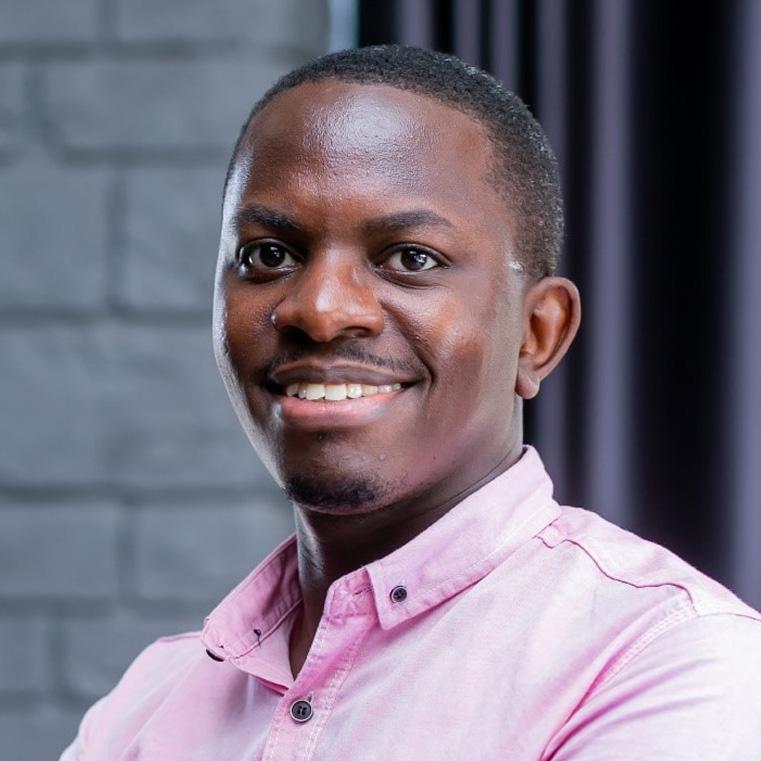
By David Masiko Senior Manager Planning and Analytics
Heard colleagues trading captain picks or speaking about deadline day on a Friday afternoon and felt lost? Well, get ready to get in on the fun as I’ve got you covered! Welcome to the Fantasy Premier League (FPL).
FPL is a free game played by millions. You pick a squad of real Premier League players, then earn points from what they do on the pitch each week. It turns casual watching of the English Premier League into smart, shared fun. No football degree is required.
You’re the manager or like we like to say, “The Gaffer”. You get a budget of £100m to build a 15-player squad from the Premier League. Each match week, you pick 11 starters and set
a captain. Your captain’s points count double. If a starter doesn’t play, someone from your bench can come in automatically. You can’t select more than three players from any single club, so you’ll spread your bets.
• 2 goalkeepers
• 5 defenders
• 5 midfielders
• 3 forwards

Your team scores when your players perform in real games.
• Goals and assists add points. Defenders and goalkeepers get more for goals, since they score less often.
• Clean sheets reward keepers and defenders.
• Minutes played matter. One point for a cameo, two for 60 minutes or more.
• Bonus points go to the top performers after each match.
Players can also lose points for red or yellow cards, own goals, or conceding goals if they’re a keeper or defender. Every action counts.
Chips: Your one-week power-ups
Use these sparingly. Only one chip can be active in any given week.
• Wildcard: Unlimited free transfers that week and you keep the new squad. You get two Wildcards in a season, one in each half.
• Free Hit: Unlimited transfers for one week only. Your old squad returns next week.
• Triple Captain: Your captain’s score is tripled.
• Bench Boost: Points from your bench count as well.
strategies
You don’t need complex spreadsheets to finish high in a mini-league. Start here.
Pick regular starters
Minutes matter more than hype. Choose players who actually play 70 to 90 minutes most weeks.
Plan two to four weeks ahead
Scan the fixture list. Target players with a run of friendlier games.
Treat transfers like a budget
You get one free transfer most weeks. Extra moves usually cost four points each. Save a free transfer when you can, then make two smart moves at once.
Form over reputation. Choose the reliable performer with a strong fixture.

Triple Captain a dependable star. Bench Boost when your entire squad has decent fixtures. Free Hit when your team is short of players. Wildcard when your squad feels stuck. Strategy is very key.
Keep notes
After each week, jot down what worked, what didn’t, and one change to try. That small habit beats guesswork.
Why this is perfect for the Fund right now
We’re reshaping culture through Project Ignite. FPL is a playful way to practice the same muscles.
Anecdotes and quick lessons
• Agility: You planned for a striker, he got injured in training. You adapt before the deadline. That’s sprint thinking.
• Data over noise: A big name blanked three weeks in a row. You back the in-form budget option and gain ground. Smart beats loud.
• Ownership: You took a risky transfer and it flopped. You learn, adjust, and move on. No blame, just better choices next time.
• Team balance: You can’t afford stars everywhere. You build a spine, then find value around it. Sounds like resourcing any project.
• Process and discipline: Deadlines are hard. Late changes cost points. Good habits protect results.
• Experiment, then commit: Try a new formation for two weeks. Review outcomes. Keep what works. Drop what doesn’t.
• Inclusion and voice: The newest manager in the office spots a rising talent. The league listens. Good ideas can come from anywhere.
Ready to join the fun?
1. Go to fantasy.premierleague.com and create your team. Don’t stress about perfection on day one. You’ll tweak as you learn.
2. Join our staff mini-league, The NSSF Elite:
• Click to auto-join: https://fantasy. premierleague.com/leagues/auto-join/ ize2iu
• Or enter the league code: ize2iu
3. Join the WhatsApp banter group to share hits and misses: https:// chat.whatsapp.com/ BRvb1LYgqHPF7VUcUZUJQ4?mode=ac_t
Five-minute first-week checklist
• Build your 15 within £100m.
• Pick your 11 starters and set a captain and vice-captain.
• Check that injured or suspended players are not in your starting eleven.
• Save your team before the weekly deadline.
• Make one note about next week’s transfer target.
A quick example
You pick a balanced squad with two reliable defenders, three creative midfielders, and a forward who’s on penalties. Your captain scores.
Your bench defender comes on for a starter who missed out. You bank your transfer this week, then make two clean moves next week without paying a points hit. You’re already learning the rhythm.
The chat on Monday. The shared highlights. The feeling that you saw a trend before it made the news. It’s light, social, and just competitive enough to sharpen your thinking. You’ll get better at planning, budgeting, and decisionmaking without calling it training.
Want a quick primer? Watch this beginner video: https://youtu.be/ xYWmhnsOqs0?si=jqhH7ZPF9iVg8nhA
See you on the leaderboard. And yes, we’ll remember who triple-captained the hat-trick hero.




By Remigious Kaggwa Engagement Specialist
It is the afternoon of 15th August 2025, the sun – ever so generous, is out in full force, daring to scorch our thoughtless heads as though we begged for it. Yet across the globe, smiles stretch wide on the faces of football-loving men and women of God. The bouquets have been paid, the boredom of over two months finally set to be buried, and official handovers of remotes have been held with due ceremony in living rooms everywhere. Because you know what?! Football is back. The English Premier League is back.
The excitement runs deep, very deep. We are all ready to sink once again into the poetic commentary of Peter Drury and the sharp insight of Jim Beglin. Of course not that we do not respect the return of other leagues elsewhere. After all, even those clubs we say play in the the farmers’ leagues have wowed us with a Champions League mug. But, let us not go there now. That conversation is best avoided, especially if we want to keep the fragile feelings of Arsenal fans intact.
Of course, there has been a fascinating buildup to this season, headlined by eye-watering spending from clubs desperate to clutch silverware. Take Liverpool, the defending champions. Every move they made in the transfer market carried the air of champions.

The exits of Trent Alexander-Arnold and Darwin Nunez might have left many fearing cracks in the their armour. But Liverpool, true to form, went on a shopping spree worthy of their champions status. In came Jeremy Frimpong and Florian Wirtz from Bayer Leverkusen, Hugo Ekitike from Eintracht Frankfurt, and the blockbuster swoop of Alexander Isak from Newcastle for a British record £125 million. Obviously we know that some of these transfers may yet rank among football’s greatest flops (or must I talk about Florian Wirtz’ stats this season oba neefuge?) but no one can accuse the Merseysiders of lacking ambition.
Then, of course, comes the matter of Arne Slot. Many of us have insisted he merely capitalised on the tactical ground laid by his predecessor. This season, however, the canvas is his alone to paint. Will he prove his mettle, or confirm the whispers that he is only a good steward of Klopp’s inheritance?
And then there is Chelsea. Yes, the Chelsea we all know. Kale we know you are “world champions”
of a FIFA competition whose credibility barely inspires anyone. But really, why buy two entire squads in one transfer market? Who is fooling who in this extravagant theatre of absurdity?
Chelsea began their buying spree the moment the season ended, and by the time the dust settled, they had signed more than eight players. One cannot deny that some of these buys are sparkling hot of course. For instance, Joao Pedro offers a guarantee of double-figure goals, while Alejandro Garnacho injects a lively spark into the attack. So you can comfortably argue that even with their trial and error approach we are braced for a glimpse of good touches from their new arrivals. And then came the most bizarre spectacle yet.
This was the first time I ever saw a club sell a player and then, within the same market, attempt to buy him back. Imagine you are Nicolas Jackson, heading to Munich to play for Bayern. You board the plane, cruising through the clouds, scroll through X to catch up on transfer news, and – boom! - you read that the same plane might need to turn back because


Chelsea want you back in London because someone in the squad has caught a hamstring. Madness! Thankfully for him, the late pursuit of Marc Guiu (another sell and buy back case) from Southampton gave Bayern’s new No. 11 a breath of fresh air, sparing him from that midair comedy.
Arsenal: Forever the Nearly Men
Now, do we really need to talk about Arsenal? Truthfully, it could be summed up in one short sentence: “as usual, they will nearly win the league.” But, for the peace of the town, let us give it more words.
The perenial unlucky Londoners recruited impressively, no doubt. Martin Zubimendi now anchors the midfield, Noni Madueke and Eberechi Eze bring flair and creativity, while Victor Gyokeres is tasked with banging in the goals. On paper, it’s a squad capable of big things.
But here’s the real story: we all know where and how things always end for this unsuspecting camp of overzealous fans…. “nearly winning the league”. Something just doesn’t add up for this very thristy side. And yet every Arsenal fan has become a full-time football pundit and transfer analyst. From boda boda cyclists to butchers, from high-ranking clergy to traditional healers, taxi conductors to mechanics - everywhere you turn, someone is prophesying Arsenal’s

impending glory. Even within our own Fund establishment, you can’t peacefully enjoy a plate of “Amagara Kigere” at the cafeteria without one of them leaning over your shoulder to declare, “this is our year.” And still, the lingering question remains: oba nga bwebawangula ddi? (When exactly did they win?)
Manchester United: From Princes to Punchlines
Lastly, the red titans of Manchester, the Princes of England, the architects of winning, artisans of the game. But in truth? Biwanvu. Yes, they boast an attack of promise: Brian Mbeumo, Matheus Cunha, and Benjamin Sesko. Yet, beyond that, nothing seems right. Things are so bad that some curious fans have gone as far as linking the club’s fate to an ancient curse, which many of us find laughable? Perhaps. But after watching Andre Onana between the sticks for what felt like eternity, you begin to wonder if a curse isn’t the only logical explanation.
And then came Ruben Amorim. Once hyped as the next great manager, he has since been revealed as a scam artist in a tracksuit, another fraudster making a living on the pitch. Manchester United’s tragedy is no longer just sporting - it is spiritual. And because of that, I’ll


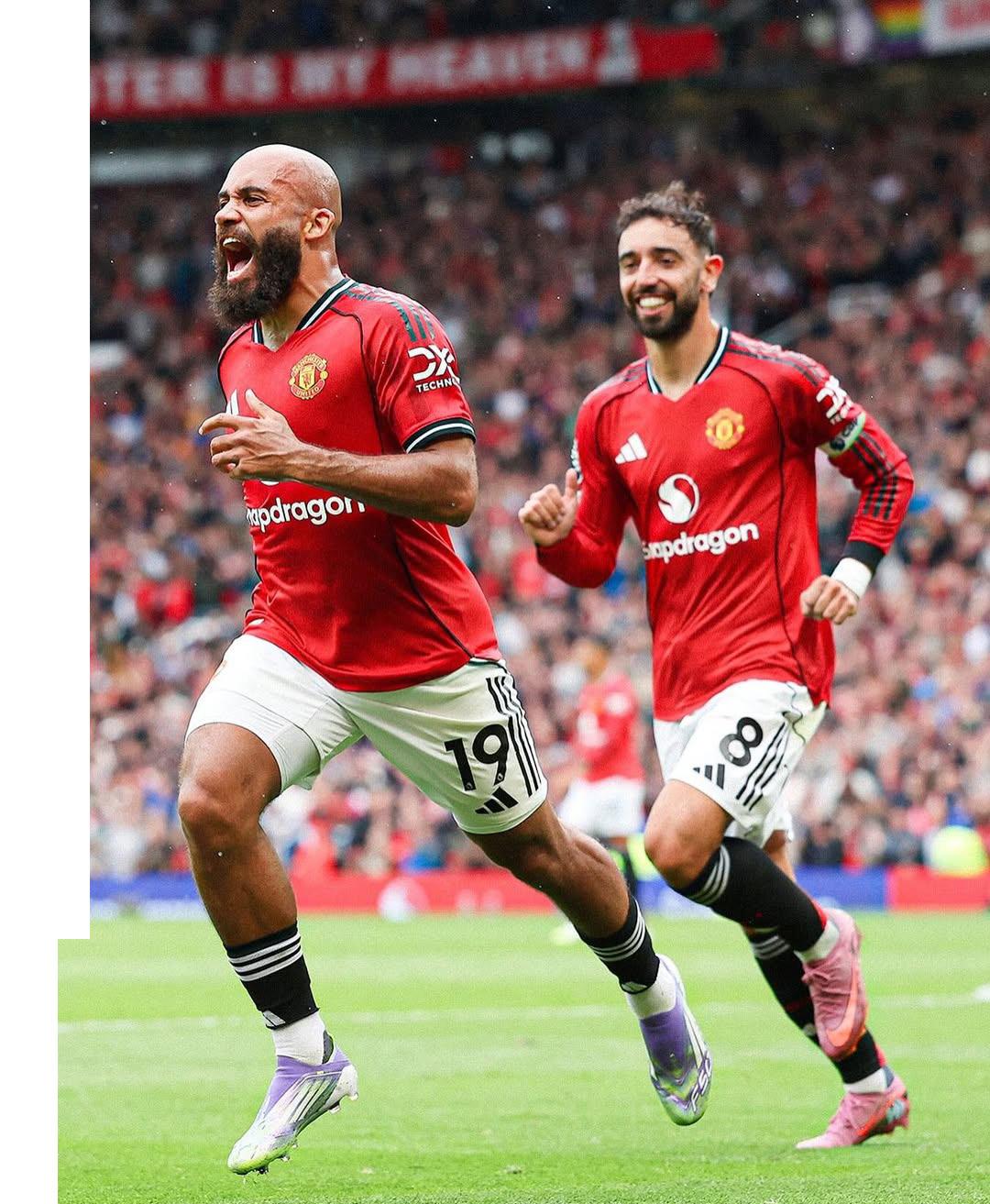


Geofrey Gary Mabonga Customer Service Officer
The Comrades Marathon 2025 will forever stand as one of the most defining chapters of my life. It was not just a race—it was a test of discipline, resilience, and an opportunity for profound personal growth.
Training began months in advance, long before the rest of the city woke up. By 4:00 a.m. sharp, I was already on the road with my two committed training partners, Ellis K and Vincent Eron. Together, we carved our way through the dark, silent streets, fueled by a shared dream.
But mornings alone weren’t enough. Afternoons and evenings were equally demanding, under the guidance of our tireless coach Godfrey Kamya, the unwavering motivation of Eng. Ronnie Namugera, and the boundless energy of the Team Nakasero crew. Day after day, stride after stride, we forged strength, endurance, and unity.
“
I remain
deeply grateful to my employer and management. Their support—through the wellness program and beyond—allowed me not only to train effectively but also to travel, participate, and ultimately complete this incredible race. That backing was more than logistical; it gave me the mental confidence to endure.
Although I grew up in the world of rugby— playing from school level to the highest stages— nothing compares to what Comrades demanded. My current professional life in compliance and administration is worlds apart from endurance sport, yet the lessons intertwined beautifully. Transitioning from team dynamics to the lonely grind of ultra-running has been humbling. I often joke that I’m almost a sports graduate now. Perhaps after I conquer the Up Run, I’ll finally earn that “degree”!
solidarity—strangers helping strangers in the middle of a grueling race—is the true essence of Comrades.
The support from the crowd was extraordinary. Families lined the route with food, drinks, cheers, and encouragement. The atmosphere was electric yet tender. I couldn’t help but think: If only our own communities could mirror this spirit—without boda bodas weaving through runners or impatient drivers honking—just

The marathon itself was a battlefield of body and mind. Every few kilometers, someone fell. Some collapsed from sheer exhaustion, others tripped on road reflectors that seemed like mountains to weary eyes.
One moment remains vivid in my heart: a woman stumbled badly, her sunglasses and bottle scattering across the road. I stopped to help her, as did other strangers, even though her teammates had pushed on. That spirit of
pure humanity coming together in support.
One of the most touching scenes was a young girl handing her father a sandwich, insisting he eat even though he still had 47 km to go. That simple act of love struck me deeply and reminded me what endurance really means: love in motion.
Another unforgettable moment was our silent anxiety for Mr. Robert Kabushenga. As the race
dragged on, we worried the clock would defeat him. Noel kept refreshing updates. When the news came—he had crossed the finish line— we erupted in joy and relief. That moment reminded us how much we admire him, not just as a leader, but as a symbol of perseverance, humility, and strength.
Lessons for Life
Comrades is more than a marathon—it’s a mirror to life. It teaches you to appreciate God’s grace, to endure pain without breaking, to love more openly, to listen more deeply, and to embrace growth through struggle. From the
earliest training runs to the final strides of race day, the transformation is undeniable.
I finish this chapter a stronger person, a more present teammate, and better equipped to face life’s challenges.
We did it. And now, with respect and anticipation, we turn our eyes to the next great test: The Up Run.
On, on.
